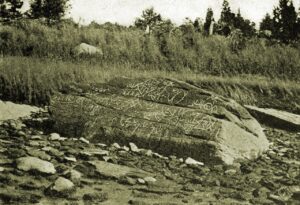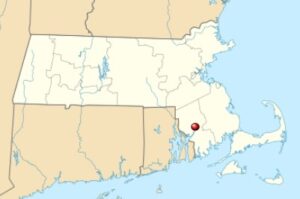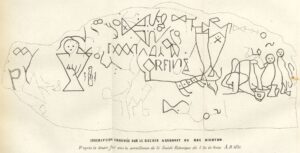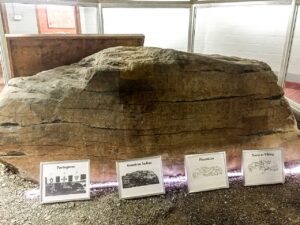
 The Dighton Rock is a 40-ton boulder that was found in the riverbed of the Taunton River at located Berkley, Massachusetts, over 300 years ago. The rock has puzzling petroglyphs on it that have apparently never been able to be deciphered. Dighton Rock is one of the greatest mysteries of Massachusetts. The boulder is slanted and has six sides. It is approximately 5′ high, 9½’ wide, and 11′ long. All of those 300 years, people have wondered about the lines, geometric shapes, drawings, and writing that appear on the rock and who created them. They wanted to figure it out. What did it mean? Who made those markings, so many years ago. No one really knows how long ago the marks were made, only about how long ago it was found.
The Dighton Rock is a 40-ton boulder that was found in the riverbed of the Taunton River at located Berkley, Massachusetts, over 300 years ago. The rock has puzzling petroglyphs on it that have apparently never been able to be deciphered. Dighton Rock is one of the greatest mysteries of Massachusetts. The boulder is slanted and has six sides. It is approximately 5′ high, 9½’ wide, and 11′ long. All of those 300 years, people have wondered about the lines, geometric shapes, drawings, and writing that appear on the rock and who created them. They wanted to figure it out. What did it mean? Who made those markings, so many years ago. No one really knows how long ago the marks were made, only about how long ago it was found.
The rock has been studied by many people over the years. In 1680, English colonist Reverend John Danforth drew a copy of the petroglyphs. That drawing has been preserved in the British Museum, but there are conflicts as to the accuracy of the drawing. Some say the markings aren’t exactly the same as the rock. In something as intricate as petroglyphs, accuracy would be of vital importance. Ten years later, in 1690 Reverend Cotton Mather described the rock in his book, The Wonderful Works of God Commemorated: “Among the other Curiosities of New England, one is that of a mighty Rock, on a perpendicular side whereof by a River, which at High Tide covers part of it, there are very deeply Engraved, no man alive knows How or When about half a score Lines, near Ten Foot Long, and a foot and half broad, filled with strange Characters: which would suggest as odd Thoughts about them that were here before us, as there are odd Shapes in that Elaborate Monument…”
One theory suggests that Indigenous peoples of North America…who were known to have inscribed petroglyphs in rocks (a schematic face on the Dighton Rock is similar to an Indian petroglyph in Eastern Vermont) made the markings. A second theory suggests that Ancient Phoenicians made them was proposed in 1783 by Ezra Stiles in his “Election Sermon” as the “descendants of the sons of Japheth.” Still another theory suggests that the Norse might have made them. That theory was proposed by Carl Christian Rafn in 1837, but it was rejected by archaeologists such as TD Kendrick and Kenneth Feder. Others suggested that the Portuguese may have made them. That was proposed in 1912 by Edmund B Delabarre, who (after seeing Portuguese writing) believed that they then used the rock for their own inscriptions. Delabarre wrote that “markings on the Dighton Rock suggest that Miguel Corte-Real reached New England. Delabarre stated that the markings were abbreviated Latin, and the message, translated into English, reads as follows: “I, Miguel Cortereal, 1511. In this place, by the will of God, I became a chief of the Indians.'” Of his findings, Douglas Hunter wrote in his book “Reconstructing the 
 history of writing about Dighton Rock” provides copious evidence and analysis debunking the Corte-Real origin myth. Lastly, the Chinese have also been suggested as a possible source, proposed by Gavin Menzies in his 2002 book “1421: The Year China Discovered America.” I don’t think we’ll ever know who made them or what they mean.
history of writing about Dighton Rock” provides copious evidence and analysis debunking the Corte-Real origin myth. Lastly, the Chinese have also been suggested as a possible source, proposed by Gavin Menzies in his 2002 book “1421: The Year China Discovered America.” I don’t think we’ll ever know who made them or what they mean.


Leave a Reply